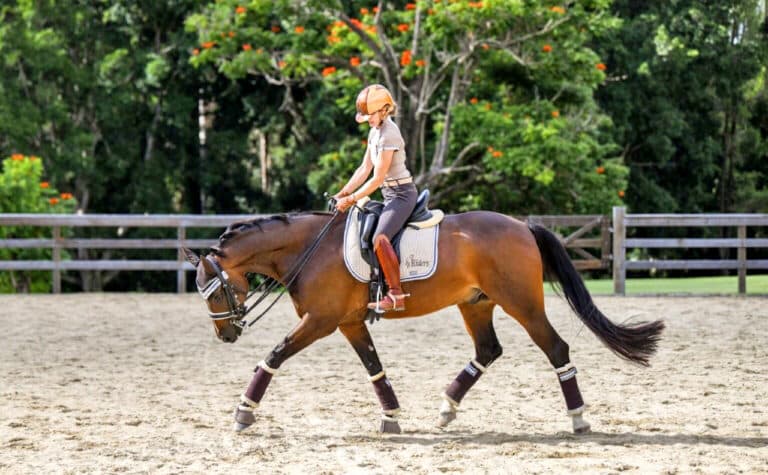You’ve probably heard that expression countless times. Now top dressage rider NICOLE TOUGH goes deep into the detail.
When we observe a horse grazing in the paddock, we can see that the forehand of the horse (encompassing their front legs, shoulders, wither, neck and head) has more weight to carry than the haunches (their hind legs, hips, tail). In other words, horses are naturally balanced with more weight distributed on the forehand. It is only when they are pumped with adrenalin do we see them change this balance and prance around their paddock like Valegro!
Now let’s add a rider on their back to this natural balance towards the forehand, and the game changes again. It is the goal of dressage training to engage the topline muscles of the horse, creating an arch in the bridge of the back, resulting in a shift in their natural balance, with more weight distribution on the haunches and a magical uphill way of going.
Even at preliminary level, the horse should be in balance towards the haunches with a degree of uphill tendency. Then, as we progress through the levels, because of increased engagement and collection, the horse should develop a more and more uphill way of going, becoming less and less on the forehand.
A good tip from dressage master Vince Corvi is to imagine the first four plaits from the wither going up like steps. However, the problem lies in how we as riders try to achieve this. We should not just lift the neck with the reins. This technique is incorrect and creates a strong feeling in the hand, and/or a hollow back, a braced under-neck with hind legs trailing or wide behind, and, what’s more, it isn’t conducive to the goal of developing the muscular strength needed to progress through the levels.

When the horse is balanced on the hind leg, we can see the hind leg under the centre of gravity.
Training your horse to come off the forehand and carry more of their weight behind is fundamental to success, and a hard technique to understand and master. Without it, the horse will struggle with test movements and your marks will suffer. I’m reminded of something International 5* judge Cara Whitman said in a masterclass in New Zealand: “Dressage is easy; unless you want to do it well, then it’s really, really hard.”
An important note: on the forehand has nothing to do with where the head and neck are, and everything to do with how the whole back and haunches are operating, and
where the point of balance is. Even in the long and low stretch down, the horse should not be on the forehand. So, how do we achieve the uphill way of going?
Transitions are the easiest way to develop and improve your horse’s balance. Your horse can appear, and maybe even feel balanced on the haunches, but any instability in self-carriage, or unevenness in the contact will be highlighted when you ask for a change of, or within, the pace. If the rider inadvertently allows a transition in which the horse becomes heavier in the contact (losing balance onto the forehand), it will take two to three corrections to override the transition they allowed to go downhill. In all transitions, it should feel like the horse achieves them bum first with no weight change in the hand, rather than nose first, when more weight comes onto the hand. The goal is never to accept or finish a transition where the balance changes and goes onto the forehand.
Eventually, and with lots of practise and dedication, a rider can rebalance a horse to the haunches with an effective half-halt. With their core fully switched on, the rider can give a quick kick to produce a reaction in the hind leg (but not a faster step), creating an upward adjustment. Imagine riding your horse and someone throwing a witches hat six meters in front of your current position. What you should feel is a sudden growth; and that is the feeling you get in the saddle from an effective half-halt – that your horse suddenly becomes a hand taller at the wither with an engaged hind leg.
In short, the rein is not there for the horse to lean on, and the horse should carry their own head and neck by being balanced on the hind leg. And a big tip is that because the horse is very good at training the rider into accepting how they want to go (on the forehand), a coach is essential to help the rider recognise the moment when the horse starts to lose balance in the transition, so that instead of finishing it, the rider makes a balancing correction and tries again.
It’s also important to remember that asking the horse to engage and develop its topline is hard work, and they will whinge about it. Let’s face it, most horses would prefer to be couch potatoes, and not go to the gym. Sound familiar? But no one gets better on the couch.
Happy training!
Feature Image: Even in the lowered frame it is possible for horses to be more balanced on the haunches.



